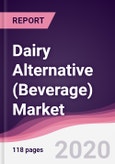What is Dairy Alternatives (Beverage) Market?
Non-dairy milk options are comparatively more economically viable, tasty and nutritious at the same time. They are made up of different types of nuts and seeds and with sweet and non-sweet formulation. This food sources are really important part for a healthy, balanced diet as these contains proteins and vitamins, but most preferably calcium which is essential for strong & healthy bones. Non-dairy milk could grow even more in the future with the addition of more health benefits. It also contains Iodine, Vitamin B12, and Vitamin B2 which are important for healthy nerve, red blood cells, brain function and healthy skin.
This report incorporates an in-depth assessment of Dairy Alternatives Market by type, Formulation, Distribution Channel, Shelf Life, Nutritive Components, Application and Geography.
What are the major applications for Dairy Alternatives (Beverage) Market?
The various applications assessed includes Food, Creamer, Yogurt, Pudding, Ice Cream, Snacks and Beverages. Majorly used are food and Creamer which influences consumers in the market and remains competitive. As everyone are concerned towards food safety which helps in driving healthier food choices and staying fit. And also ethnic flavoring still drives a majority of health food markets, playing a pivotal role in product uptake as these alternatives keep buyers engaged all the time.
Market Research and Market Trends of Dairy Alternatives (Beverage) Market
- Plant-Based Milk Alternatives: Growth in plant-based milks like health concerns, with an increasing number of consumers coming to trust that the plant-based foods are healthier than animal-based foods. In addition, growing consumer base which is influenced by animal welfare concerns, heading them to pick plant-based beverages, as well as other plant-based foods over animal-based products. The plant-based food and drinks have become increasingly popular among consumers treating them as dairy replacement and attaining a market worth $16bn.
- Plain and flavored, sweet and non-sweetened are among the key identified non-dairy formulation. Sweetened and flavored category is forecasted to be fastest evolving market category due to its acceptableness in great number of products. Importantly, beverage companies are concentrating on enhancing taste by mixing flavors and taste improvers and sweeteners in the product range.
- Organic: The organic label facilitates extra benefit for consumers to identify the product which is providing high rich and hygiene dairy substitutes in the market. In addition, supermarkets are highlighting these features to attract high-end consumers by increasing discounts, enhancing quality rate, improving organic ranges to make buyers to indulge in this for a longer period of time. Organic products like soy drinks and other dairy alternatives are influencing market especially in South-Asia and European countries.
- Coconut milk segment is increasing in application areas ranging from confectionery, snacks and yoghurt to frozen dessert. Newer varieties of coconut milk like coconut milk powder are being introduced, which in addition supports its growth in the dairy alternatives market. As it is a good source of energy and enables nutrients such as electrolytes, minerals and vitamins.
- Sterilized Soy Milk: In order to terminate the protein energy malnutrition, many countries are influenced to use this protein rich soy milk which has immense health benefits. This milk has greater quality as it was processed under conditions involving specific room temperature, pH, standard plate count and mold count. Shelf life of this milk can be considerable up to 170 days in controlled refrigerated conditions. Majority of consumers are showing interest in using this product which has a greater shelf life than any other milk product.
Who are the Major Players in Dairy Alternatives (Beverage) market?
The companies referred to in the market research report includes White Wave Foods Company, Hain Celestial Group Inc, Blue Diamond Growers Inc, Organic Valley, SunOpta Inc., Sanitarium Health and Wellbeing Company, Freedom Foods Group Limited, Kikkoman, Vitasoy International Holdings Limited, Living Harvest Foods Inc. and more than 20 companies
What is our report scope?
The report incorporates in-depth assessment of the competitive landscape, product market sizing, product benchmarking, market trends, product developments, financial analysis, strategic analysis and so on to gauge the impact forces and potential opportunities of the market. Apart from this the report also includes a study of major developments in the market such as product launches, agreements, acquisitions, collaborations, mergers and so on to comprehend the prevailing market dynamics at present and its impact during the forecast period 2020-2025.
Key Takeaways from this Report
- Evaluate market potential through analyzing growth rates (CAGR %), Volume (Units) and Value ($M) data given at country level – for product types, end use applications and by different industry verticals.
- Understand the different dynamics influencing the market – key driving factors, challenges and hidden opportunities.
- Get in-depth insights on your competitor performance – market shares, strategies, financial benchmarking, product benchmarking, SWOT and more.
- Analyze the sales and distribution channels across key geographies to improve top-line revenues.
- Understand the industry supply chain with a deep-dive on the value augmentation at each step, in order to optimize value and bring efficiencies in your processes.
- Get a quick outlook on the market entropy – M&A’s, deals, partnerships, product launches of all key players for the past 4 years.
- Evaluate the supply-demand gaps, import-export statistics and regulatory landscape for more than top 20 countries globally for the market.
Table of Contents
Methodology

LOADING...








